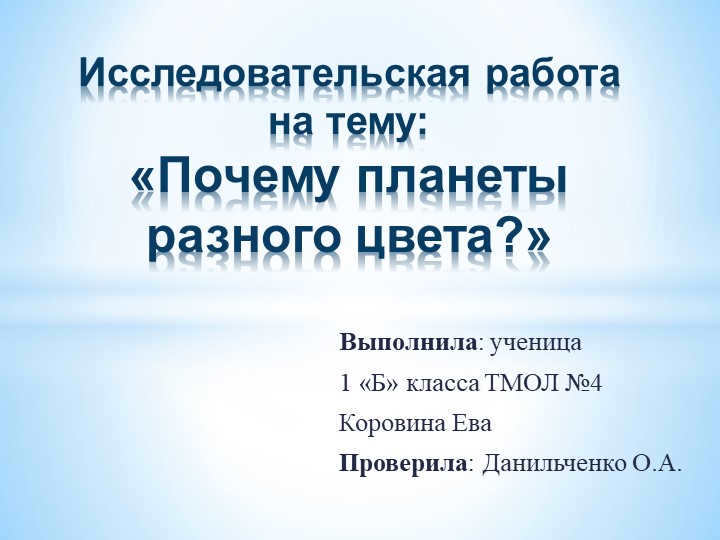
Currently, there are additional cumulative discounts (ranging from 2% to 25%) available for 58,742 educational establishments. To determine the applicable discount for all staff members of your educational institution, please login to your personal Infoworks account.

Continuing education program
Unique aspects of fostering critical thinking skills in elementary school students.
We can combine your school’s discount with this offer (the amount will vary based on the number of your colleagues who have completed Infoworks courses).
Currently, 58,742 educational institutions are eligible for additional discounts (ranging from 2% to 25%). To determine the discount available to all employees at your school, please log in to your personal Infoworks account.


Advanced training program
Implementation of the Federal Educational Program of Primary General Education
We can apply a special discount for your educational institution (the amount of discount depends on the number of your colleagues who have completed Infoworks courses)
Currently, there are 58,742 educational institutions that are eligible for additional discounts (ranging from 2% to 25%). To find out the specific discount available for all employees of your educational institution, please login to your personal Infoworks account.


Approaches to Cultivating Leadership Qualities in Middle School Students
Breakdown of the Presentation Slide by Slide:


Slide 1 created by Eva Korovina, a student from class 1B at TMOL №4. Checked by O.A. Danilchenko.
Research conducted on the topic: “What causes the variation in colors among planets?”
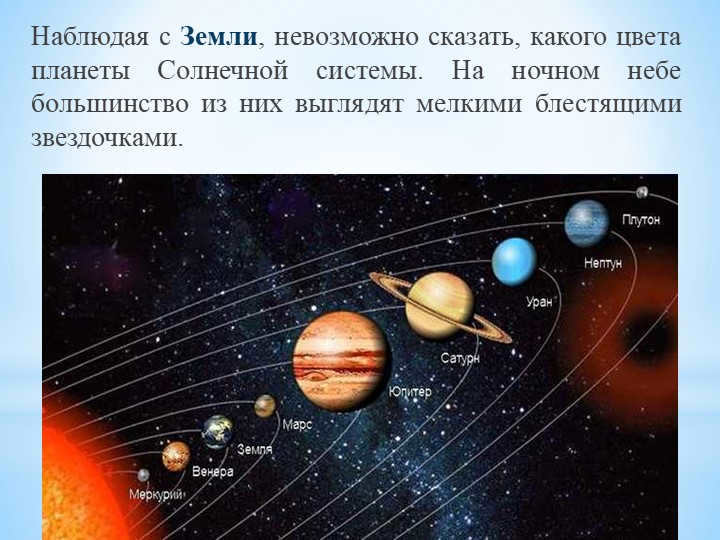

2nd slide When observing from Earth, it is difficult to determine the true color of the planets in the solar system. In the night sky, they mostly appear as small, twinkling stars.
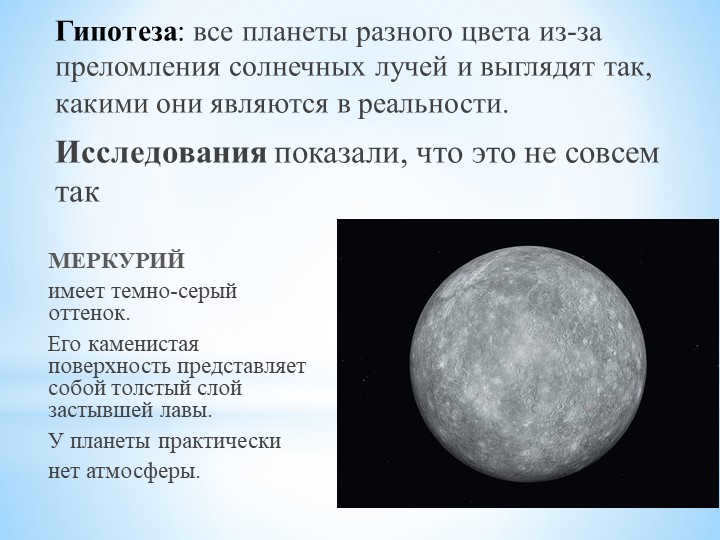
There is a hypothesis that suggests that the different colors of planets are a result of sunlight refraction, and that their appearance is a true representation of their nature. However, research has indicated that this hypothesis is not entirely accurate.
MERCURY
appears as a dark gray color. Its surface is composed of a thick layer of solidified lava. Additionally, the planet has an extremely minimal atmosphere.
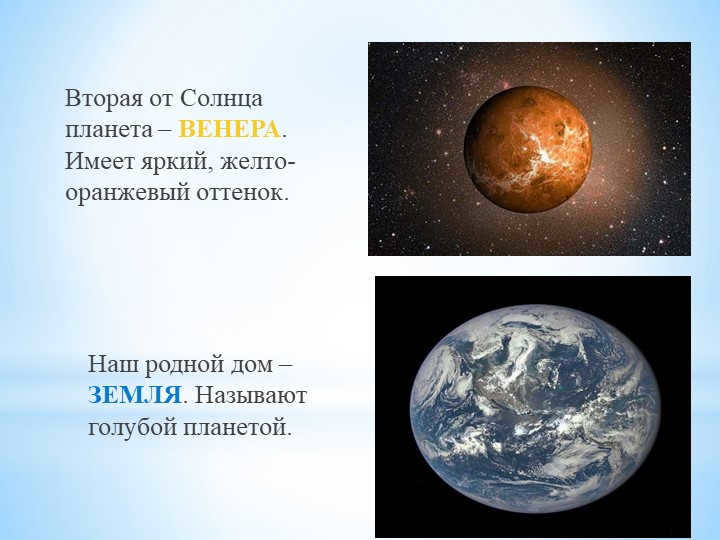

Slide 4: VENERA is the second planet from the Sun and it is known for its bright, yellow-orange hue. Meanwhile, our home planet, EARTH, is often called the blue planet.
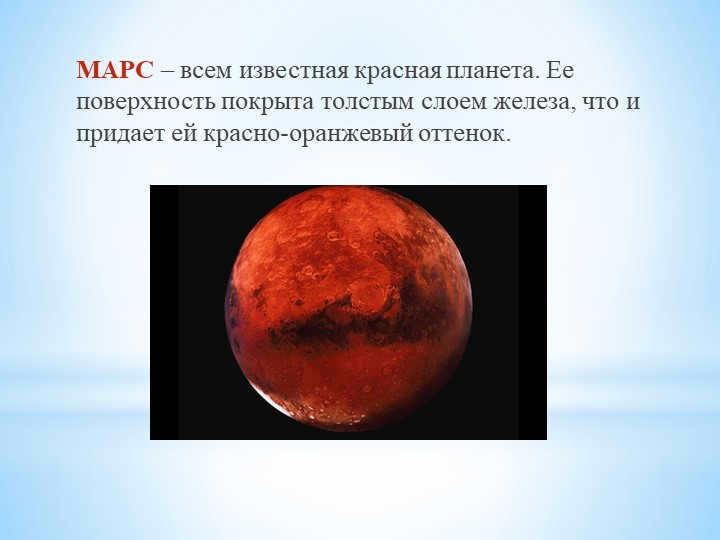

Slide 5 MARS is famously known as the red planet. It has a surface that is coated with a dense layer of iron, resulting in its distinct red-orange hue.
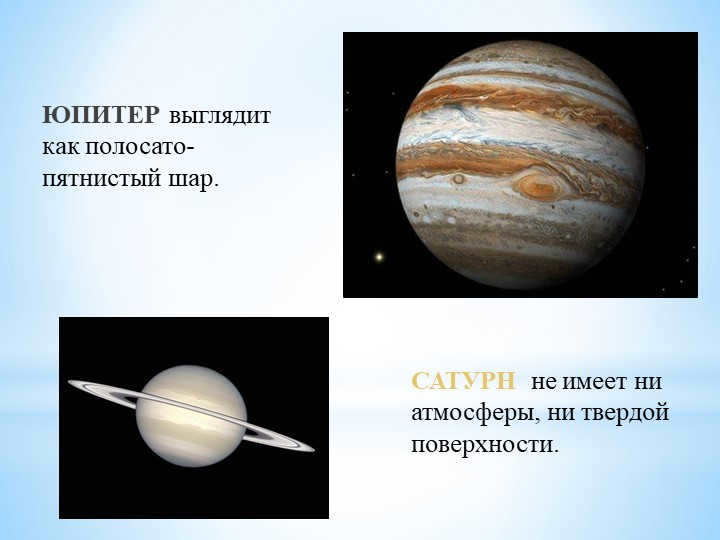
The appearance of JUPITER’s 6th slide resembles a ball with stripes and spots.
SATURN, on the other hand, lacks an atmosphere or solid surface.

Slide 7: Uranus is a greenish-blue ball. Neptune shares a similar color with Uranus. The massive atmospheric vortices on Neptune’s surface appear as dark blue spots.

Conclusion of Slide 8:
All planets display a variety of colors, which can be attributed to the refraction of sunlight and the presence or absence of an atmosphere.

Summary of the Document:
When observing the planets of our solar system from Earth, it is not possible to determine their true colors. They appear as small, shiny stars in the night sky, and the ones that are farthest away cannot be seen at all. To truly see the colors of these celestial bodies, we rely on photographs taken from space or the use of powerful telescopes.
Initially, it was hypothesized that all planets have different colors due to the refraction of sunlight, giving them a more realistic appearance. However, studies have shown that this is not entirely accurate.
MERCURY, for example, has a dark gray hue. Its surface is made up of a thick layer of solidified lava.
VENERA, on the other hand, has a bright yellow-orange color which is a result of its dense layer of acid clouds.
Our home planet, EARTH, is often referred to as the blue planet. This is because of the abundance of seas and oceans that give it its blue color.
MARS, also known as the red planet, has a surface covered in a thick layer of iron, which gives it its distinctive red-orange color.
JUPITER appears as a striped and spotted ball, while SATURN lacks a solid surface and atmosphere. In images, it appears as a pale yellow color with gray-brown gas rings.
The ice giant, Uranus, is a greenish-blue ball, while NEPTUNE is quite similar in color. However, Neptune is darker due to its distance from the Sun and has a higher concentration of methane in its atmosphere.
In conclusion, all planets have different colors, but this is not solely due to the refraction of sunlight. The presence or absence of an atmosphere also plays a significant role.
Teaching resources and educational materials for instructors and educators
More than 10,000 instructional materials for both classroom and remote learning
The language of color is one of the oldest and most persuasive forms of human communication. It largely relies on a person’s level of development and serves to characterize them as an individual. The impact of color and shades in ceremonial attire, sacrificial rituals, and body paint for combat purposes is a means of protection against environmental aggression. Ancient civilizations formed the fundamental psychological concepts regarding the influence of color on humans. Primitive societies associated colors with natural forces, such as fire represented by red, the Sun represented by orange and gold, spring foliage and new life represented by green, and the sky and sea represented by blue. More enlightened civilizations discovered a link between color and planetary influence, which also formed the basis for the ancient correspondence system between metals and stones. For example, gold represented the Sun, while silver represented the Moon due to their corresponding colors. Other colors in antiquity were also attributed to different planets, such as red for Mars, green for Venus, purple or dark blue for Jupiter, black or brown for Saturn, and varying colors for Mercury. Remarkably, modern scientific research has later confirmed this information.
Earth is a planet that appears blue, with a light blue hue, and is adorned with a layer of white clouds. The dominant color of the planet is largely influenced by its extensive water coverage.
Mercury, on the other hand, is a planet characterized by a grayish hue. This celestial body lacks both an atmosphere and water, consisting solely of rocky terrain.
Venus possesses a yellowish-white color, which is primarily attributed to the clouds enveloping its surface. These clouds contain hydrochloric acid.
Mars, often referred to as the “red planet,” actually exhibits a reddish-orange hue. Its name is derived from the color of its desert-like soil, which contains significant amounts of iron.
Jupiter, being a colossal sphere of liquid, showcases an orange-yellow hue as its predominant color. This coloration is a result of the presence of ammonia and ammonium gases within the planet’s clouds, as evident in most space images.
Saturn, on the other hand, appears as a pale yellow planet. Its coloration is primarily formed by ammonia clouds, beneath which lies a layer of liquid hydrogen.
Uranus possesses a gentle blue shade, although its color is formed by the existence of methane clouds, unlike Earth.
Neptune, on the other hand, showcases a green hue, even though its chemical composition closely resembles Uranus and exhibits a bluish tint. Its color is determined by the presence of methane clouds, while its surface appears slightly darker due to its significant distance from the Sun.
Pluto boasts a light brown color, primarily due to the abundance of dirty methane ice on its surface.
In present times, there is no dispute that the planets emit their unique spectral radiation, which is meticulously recorded by appropriate instruments.
It is crucial to consider the distinct colors exhibited by each planet:
Test your own feelings towards the distinct color associated with a specific planet. It has been observed that a strong dislike for a certain color signifies that the corresponding planet in your horoscope has disharmonious aspects. Seeking guidance from an astrologer, as well as engaging in self-reflection on your horoscope, can aid in transforming your perception of this color and fostering the growth of new, harmonious traits. This approach serves as one of the methods for personal growth through the utilization of color.
At the moment of birth, every individual is influenced by their own unique astrological factors, which are rarely duplicated. Simultaneously, we are all impacted by the movements of celestial bodies. These movements interact with the various components of our personal horoscope, analogous to the bow of a violin on its strings. Depending on the aspects of the horoscope, harmonious or dissonant melodies are produced. By studying the color vibrations emitted by these celestial bodies, we enhance our understanding of one another.
The coloration of planets is largely determined by the composition of the substances that comprise them, resulting in their distinct appearances. Ongoing research in the realm of space exploration continually provides us with new information regarding the hues of the planets within our solar system. Additionally, efforts are being made to identify celestial bodies beyond our solar system.
The solar system is known for its vibrant colors
Within the solar system, there exists a limited number of planets. Certain planets were predicted by physicists and mathematicians even before the invention of advanced telescopes. However, with the advancements in astronomical science and technology, researchers have been able to observe and categorize the diverse range of colors exhibited by the planets within our solar system.
- Mercury is a planet of a gray hue. The absence of an atmosphere and water on the planet determines this color, leaving only rock.
- Next in line is Venus, a planet with a yellowish-white tint. This color is attributed to the clouds that surround the planet, which are formed by the vaporization of hydrochloric acid.
- Earth is a planet of a light blue shade, adorned with a layer of white clouds. The presence of water largely contributes to the color of our planet.
- Mars, often referred to as the “Red Planet,” is actually of a red-orange hue. This color is reminiscent of the desert soil rich in iron.
- Jupiter, the largest gaseous planet, displays an orange-yellow appearance with streaks of different colors. These colors are created by the presence of ammonia and ammonium gases in the planet’s clouds.
- Saturn is characterized by a pale yellow hue, which is predominantly formed by the presence of ammonia clouds. These clouds sit atop a layer of liquid hydrogen.
- Uranus exhibits a light blue color, which is distinct from Earth’s coloring. This hue is primarily determined by the presence of methane clouds.
- Neptune, often described as green but actually more of a blue shade, shares similarities with its twin planet Uranus in terms of its coloration. The presence of methane clouds influences the color of Neptune, and its surface appears darker due to its distance from the Sun.
- Pluto’s surface is composed of dirty methane ice, resulting in its light brown coloring.
Are there any planets beyond our solar system?
For numerous decades, astrologers and astrophysicists have been dedicatedly exploring and detecting exoplanets, which are planets located outside our solar system. Advanced telescopes circling the Earth are actively involved in this pursuit, capturing images and endeavoring to provide a precise depiction of the colors exhibited by these celestial bodies. The primary objective of these endeavors is to identify an exoplanet that is habitable and comparable to our own planet Earth amidst the vastness of the cosmos.
When searching for planets, the primary factor taken into account is the luminescence of the planet, specifically its reflection of light from a star, as seen from Earth. The color of this luminescence is not limited to just white-blue. Scientists believe that a planet with luminescence in the red spectrum could also support life. The majority of Earth’s luminescence comes from its water surface, resulting in a white-blue glow, while luminescence from vegetated land would have a reddish hue.
Currently, the exoplanets that have been discovered resemble Jupiter in terms of their characteristics.
In this article, we will explore Mercury, one of the planets in our solar system. You will discover fascinating facts about this celestial object, including its day and year length, the presence of satellites and rings, and much more.
Which planet is closest to the Sun?
Mercury holds the distinction of being the smallest planet in our solar system. Prior to 2006, Pluto held this title, but during the IAU General Assembly convention on August 24, its status as a major planet was revoked.
Mercury is located at a distance of 57,900,000 kilometers from the Sun, making it the closest planet to our star. It is followed by Venus, Earth, and Mars, with the gas giants Jupiter, Saturn, Uranus, and Neptune trailing behind. Therefore, Mercury is the first planet in our solar system in terms of proximity to the Sun.

The color of the celestial object
Observations made by space satellites and ground-based telescopes have provided valuable insights into the true color of Mercury. The planet’s surface is entirely covered with gray rocks, formed from solidified molten lava. This geological process took place billions of years ago, resulting in Mercury becoming a desolate world made up entirely of rocky terrain. Scientists have noted the absence of erosion and tectonic activity on the planet for millions of years. The only changes to the landscape occur when meteorites impact the surface, leaving behind distinct furrows.
According to geologists who have examined the images, there is no evidence of any active volcanoes on the surface of Mercury. The exact color of Mercury, had it been covered in hot magma flows, remains a mystery. However, at present, the planet appears to be a dull gray color.

Exploring the terrain
Thanks to advancements in the space industry, we now have the opportunity to gain a deeper understanding of our universe, including information about the various planets within our solar system. Let’s take a closer look at Mercury:
- A single day on Mercury lasts approximately 59 Earth days. This is the amount of time it takes for the planet to complete one full rotation on its axis.
- Mercury completes one orbit around the Sun in nearly 88 Earth days, which is equivalent to one year on this planet.
- The temperature on Mercury experiences significant fluctuations. During the night, the surface of the planet cools down to -183 degrees Celsius, while during the day, it can heat up to a scorching +430 degrees Celsius. These extreme temperature variations are due to the planet’s inability to retain heat.
- Despite being elusive in the sky, Mercury was known to our ancestors long ago.
- Among the planets in the solar system, only Venus and Mercury lack natural satellites or rings.
- Mercury possesses the largest sulfur reserves and has also been found to contain water ice and organics.
Now let’s shift our focus to planetary divination. Each planet has its own unique color, ranging from the fiery red of Mars to the deep purple of Saturn. In the spectrum of the rainbow, each color generates waves with distinct characteristics. These vibrations of the planets and colors are in correspondence with each other. Astrological divination provides us with the chance to determine which celestial body currently holds dominion over a person’s fate and how to harness this influence for positive outcomes. As scientists have long discovered, our subconscious mind is a complex entity with many facets. >>>>>
@ Dana & Gabi Satori The planets, their colors, and the laws of the universe. Here are the names of the planets, the colors associated with them, and a brief overview of the universal laws governing each planet. In the following chapter, we will delve deeper into their characteristics and explore the specific concepts and “tools” utilized by astrologers. It’s worth noting that each celestial body is symbolized by a particular color of gemstones. This color can be incorporated not only in gemstones but also in other elements. >>>>>
@ Dana and Gabi Satori, Here are some helpful tips on selecting the perfect colors based on astrology. It’s widely known that color has a profound impact on us, even when we’re unaware of it. Did you know that wearing colored underwear can actually infuse us with the energy we need? The skin contact with specific colors can help harness the qualities associated with certain planets, especially when we don’t have the option to revamp our wardrobe with the appropriate shades. So, if you’re looking to boost specific planetary qualities, this phenomenon can be quite beneficial. With. >>>>>
@ Dana & Gabi Satori Let’s examine the astrological traits associated with the hue of the planet Pluto. Do you recall when I promised to reveal the mystery behind black and red Spanish attire? Well, the moment has arrived. To start, fiery Mars is connected to Pluto, and in fact, the latter is often referred to as the “superior Mars.” As a result, the coloration of these planets is quite similar: the garnet-red Pluto differs from the vibrant scarlet shade of Mars only by the inclusion of blackness. And the symbolism involved is roughly the same. >>>>>
@ Dana & Gabi Satori Let’s explore the astrological characteristics associated with the hue of Neptune. The color violet has always captivated me with its enchanting and enigmatic nature, particularly its deeper tones infused with hints of blue. It evokes images of the mystical veil of the night sky or the vast expanse of the Universe adorned with sparkling starry diamonds. If I were to depict a sorceress, I would undoubtedly choose purple as the hue for her attire. As I delved into the realm of esotericism, I discovered that purple is also regarded as the color of the cosmic realm. >>>>>
@ Dana & Gabi Satori Let’s explore the astrological attributes associated with the hue of the planet Uranus. Are you a fan of the color blue? If not, you are in the minority. Blue is the most favored color among adults worldwide. I, too, am no exception: this clear and reminiscent-of-forget-me-nots color reminds me of a refreshing breeze in the mountains. It brings about a sense of rejuvenation, mental clarity, and a touch of angelic tranquility. >>>>>
@ Dana & Gabi Satori Explore the astrological attributes associated with the color of the planet Saturn. Individuals who possess the prominent influence of Saturn often experience depression more frequently compared to others, as astrologers commonly acknowledge. The primary group of individuals influenced by Saturn are, undoubtedly, those born under the zodiac sign of Capricorn, which is the planetary domicile of Saturn. If we compile enduring word combinations that connote a negative state of mind, aside from “black melancholy” or the same hue of yearning, we, without a doubt. >>>>>
@ Dana and Gabi Satori Take into consideration the astrological attributes associated with the color of the planet Mars. It is widely known that Mars is often referred to as the “red planet”. Its surface has a distinct brick-like color, and when observed in the sky, it appears as a bright reddish dot. This is why astrologers universally associate Mars with the color red or scarlet. It is intriguing to note that individuals with a strong Mars influence in their birth chart, particularly those born under the sign of Aries, are especially impacted by its energy. >>>>>
@ Dana and Gabi Satori Let’s explore the unique astrological qualities associated with the color of the planet Venus. When I think of this enchanting goddess, I am immediately reminded of the mesmerizing image crafted by the talented Italian Renaissance artist Sandro Botticelli: the delicate contours of her face, the ethereal strands of golden hair dancing in the breeze, the elegant seashell at her feet, and the tranquil green-blue backdrop of the sea. “Penannuated” is a renowned epithet often attributed to Venus, the divine embodiment of love and beauty, as per ancient tales. >>>>>
@ Dana and Gabi Satori Take into consideration the astrological attributes associated with the color of the planet Mercury. If something rapidly passes by you or swiftly appears before your eyes, is it easy to determine its color? In all likelihood, you will only perceive a kaleidoscope of colors, a diverse mixture of hues. This is a similar situation with Mercury, the swiftest planet in our solar system (excluding the Moon, which is merely a satellite of Earth). This quick little planet “orbits” the sun at an astonishing pace.
@ Dana and Gaby Satori Let’s explore the astrological characteristics associated with the color of the Moon. Similar to the Sun, the Moon stands out among the other planets as it is also a celestial body. However, it is not as bright and does not emit heat, making it less noticeable and watched during certain times. Nevertheless, its importance should not be underestimated. The Moon plays a crucial role in natural rhythms, affecting everything from the growth stages of plants to the physiological cycles of females. While the Sun is known for giving life and energy, its impact is more evident and perceptible. . >>>>>
@ Dana & Gabi Satori Purple is an enchanting hue reminiscent of the moon’s mystical glow. Unlike the vibrant orange, this particular shade has been said to suppress the appetite, making it an excellent choice for individuals looking to shed some pounds. Even the choice of dinnerware can play a role in one’s eating habits: opting for plates in this alluring color might subconsciously lead to consuming smaller portions. The significance of violet in color therapy Violet, as well as its derivative purple, holds immense value for individuals suffering from hypotension and heart ailments. However, it is crucial to exercise caution as an excessive exposure to violet tones can prove detrimental. When utilized in moderation, this mesmerizing hue can bring about a sense of tranquility and balance. >>>>>
@ Dana & Gabi Satori Green is the hue associated with the planet Saturn. When it comes to color therapy, the green hue of Saturn is utilized to cleanse the astral body. A shade known as yellow-green combines the characteristics of both yellow and green, and its soothing effect on the body is quite powerful. The utilization of light green shades in color therapy promotes a sense of tranquility, whereas darker and muddier shades can evoke a somber mood. Furthermore, the color green helps alleviate nervous distress. >>>>>
@ Dana & Gabi Satori The color associated with Mercury is yellow. It has been found to be beneficial for gastrointestinal disorders. The yellow color of Mercury is particularly helpful for the liver and intestines. When the skin becomes yellow, it is often seen as a worrisome sign. People immediately associate it with hepatitis or liver failure. However, it may surprise you to learn that yellow products can actually promote a healthy complexion. >>>>>
@ Dana & Gabi Satori Blue is the hue of Venus. The azure shade of Venus provides a unique and tranquilizing impact. Individuals engaged in mental labor will discover it significantly more effortless to focus in an environment adorned with a blue-hued lamp or curtains. This hue has a soothing effect on frayed nerves, and it is also beneficial for individuals with weak eyesight. In color therapy, the utilization of blue hues is quite common. Being surrounded by a deep blue shade creates a sense of security, similar to the effects of a greenish-blue hue. Additionally, in terms of nutrition, the incorporation of blue hues can play a significant role. >>>>>
@ Dana & Gabi Satori Take into account the insights of astrology when it comes to the meaning of different colors. The chakras, which are the energy centers in our body, receive nourishment through various means, including the colors present in our surroundings. This is because the seven fundamental natural colors are connected to both our physical and spiritual being. The significance of colors in astrology is that our aura absorbs their energy, making them essential for our soul’s sustenance. As a result, each color has a unique impact on our mental and physical well-being. It is quite common for us to… >>>>>
@Dana & Gabi Satori A square of green aspects has the power to dismantle old mindsets and compel a fresh approach to forming connections, but it does not enhance emotional profundity. There is no growth, only a shift from one state to another. The significance of green aspects in astrology lies in their representation of liberation from constraints. They embody movement that leads nowhere. It is a cyclical pattern. Quintile denotes pivotal transformations, be it one or two. It signifies an individual leaving one profession behind and embarking on another. Quintil Roe. >>>>>
@ Dana and Gabi Satori Each celestial body in astrology possesses a unique hue. The Moon, which governs the zodiac sign Cancer, is represented by the color white. In terms of its fundamental traits, it is considered a magnetic and aqueous (alongside Neptune) planet. The influence of the white moon color is more pronounced on females than males. The significance of the color white, symbolizing the moon, likely explains why women in temperate regions tend to prefer white clothing (while in tropical regions, it is commonly worn by both genders as a means of protection against excessive solar energy). From meta. >>>>>
Dana and Gabi Satori Black represents the power of Saturn, which governs Aquarius (during the day) and Capricorn (at night). Saturn, along with the Moon, Venus, and Neptune, are classified as magnetic planets. It is believed that women are more receptive to magnetism than men. The color associated with Saturn is black, so women are more affected by the “strict black color” of clothing than men. In terms of metals, it corresponds to lead, and in terms of stones, it corresponds to magnetic x. >>>>>
@ Dana and Gabi Satori Green with a bluish tinge is associated with Venus, the ruler of the Earth trigon (which combines the signs: Taurus, Virgo, Capricorn). Venus governs Libra, the daytime sign, and Taurus, the nighttime sign. The green color of Venus corresponds to the metal copper, stones such as blue spar and azure lapis, parts of plants including flowers, and the symbol of society – children. The use of the green color, which is associated with Venus, has various effects. It has a calming effect, balances actions, and instills courage (for example, determination).
The red color is associated with the planet Mars, which is the ruler of the fire trigon and corresponds to the zodiac signs Aries, Leo, and Sagittarius. Mars governs Aries during the day and Taurus during the night. In terms of metals, the red color of Mars corresponds to heated iron, and in terms of stones, it is compared to the energy of a diamond. In plants, Mars governs the growth of the trunk. In terms of bioenergetics, the red color of Mars can either excite or irritate, depending on the individual’s state. The energy of the red color of Mars is powerful and dynamic. >>>>>
@ Dana & Gabi Satori Each individual has the ability to utilize the appropriate colors in astrology. By carefully observing the celestial sky, one can observe that the stars emit rays of varying hues to the Earth: Mars (known in mythology as the god of war) radiates a red color, Venus (the goddess of love, protector of women and brides) emits a bluish hue, the Moon (the giver of life to female strength and honor) shines with a brilliant white glow, and so on. The significance of colors in astrology is profound. Astrologers believe that individuals born under “colored.”
What are the colors associated with the planets of our solar system? Let’s find out the best answer:
Answer from Andrey Egorov [newcomer]
diverse
Answer from Milena [active].
Mercury is a planet with a grayish hue. This color is a result of the absence of an atmosphere and water, leaving only solid rock. The next planet in line is Venus, which exhibits a yellowish-white shade. This color is attributed to the clouds that encase the planet, which are composed of vaporized hydrochloric acid. Earth, on the other hand, is a blue planet with a light blue hue and a layer of white clouds. The predominant color of our planet is primarily influenced by its vast water coverage. Mars, often referred to as the “Red Planet,” is actually more of a reddish-orange. This color can be attributed to the iron-rich soil found in its desert regions. Jupiter, the largest planet in our solar system, presents itself as a colossal liquid sphere with an orange-yellow tint and distinctive bands of color. These hues are a result of the presence of ammonia and ammonium gases in its atmosphere. Saturn, on the other hand, has a pale yellowish hue, which is also formed by the clouds of ammonia. Beneath these clouds lies a layer of liquid hydrogen. Uranus, with its light blue shade, differs from Earth in that its color is formed by the presence of methane clouds. Neptune, a planet that appears green but is more accurately described as a shade of blue, shares similarities with Uranus. Its color is determined by the presence of methane clouds, and its surface appears darker due to its greater distance from the Sun. Lastly, Pluto, with its light brown hue, owes its color to the presence of dirty methane ice on its surface.
Response from Mr. Michael [guru].
Mercury has an ash-colored appearance, Venus is characterized by a white-poison-green hue, Earth is known for its blue color, Mars has a pale orange-rusty tint, Jupiter displays white-brown streaks, Saturn has a light beige tone, Uranus is distinguished by its gray-blue shade, and Neptune shines in a bright blue color.
Reply from Vladislav [guru]
stop hallucinating
The vastness of space has always captivated humanity with its enigmatic nature and unexplored depths. Throughout the centuries, mankind has tirelessly endeavored to unravel the secrets it holds. With the advancement of the space industry, our understanding of the Solar System and distant galaxies has significantly evolved. Nevertheless, there is still much that remains undiscovered and beyond our comprehension, leaving plenty of opportunities for future exploration.
Today, we will explore Mercury, one of the fascinating planets in our solar system. This celestial body offers numerous intriguing aspects to discover, such as its day and year duration, the presence of satellites and rings, and much more.
Which planet is closest to the Sun?
Mercury holds the distinction of being the smallest planet in our solar system. This title was previously held by Pluto until 2006 when it was stripped of its status as a large planet during the IAU General Assembly convention on August 24.
Mercury’s distance from the Sun is approximately 57,900,000 kilometers, making it the planet closest to our star. Following Mercury are Venus, Earth, and Mars, and beyond the asteroid belt lie the colossal celestial bodies: Jupiter, Saturn, Uranus, and Neptune. Therefore, Mercury is positioned as the first planet from the Sun in our solar system.
The hue of the celestial entity
By utilizing imagery captured by space satellites and ground-based telescopes, it has been feasible to accurately determine the coloration of Mercury. The entire exterior of the planet is adorned with ashen boulders, which originated from the solidification of molten lava. The cooling of the magma and subsequent formation of the rocky formations transpired billions of years ago. Presently, Mercury is a celestial body entirely comprised of exposed rock. According to scientific researchers, there have been no indications of erosion or tectonic activities transpiring on the planet for several million years. The planetary topography undergoes alteration solely due to meteorite impacts, which leave behind grooves on Mercury’s surface.
According to geologists who have examined the images, there have been no recorded instances of active volcanoes on Mercury, the closest planet to the Sun. We can only speculate on the color of Mercury if it were painted by the hot magma flows. However, at present, it appears to us as a featureless gray planet.
Exploration of the Landscape
The Messenger spacecraft has observed the surface of Mercury, capturing several thousand high-quality images that have been provided to scientists for analysis. These photos provide a clear indication of the color of Mercury, which is predominantly a dark gray hue.
These photographs, captured by a satellite, exhibit a remarkable level of detail. Through careful analysis, scientists have discovered the formation of light-colored indentations on the surface of Mercury, indicating recent changes to the planet’s landscape.
The progress of the space industry has provided us with invaluable insights into the vast expanse of our universe, including the planets within our solar system. Mercury, in particular, offers fascinating characteristics:
- A single rotation on Mercury lasts approximately 59 Earth days, defining the duration of a day on this planet.
- In its orbit around the Sun, Mercury completes a full revolution in nearly 88 Earth days, constituting the length of a year on this celestial body.
- The composition of Mercury’s exosphere, which is a type of atmosphere, changes depending on its distance from the Sun. Scientists have discovered that it contains sodium, calcium, and magnesium, and the concentration of these substances varies as we move closer or farther away from the Sun.
- Although locating Mercury in the sky can be challenging, our ancestors had knowledge of its existence thousands of years ago.
- Venus and Mercury are the only two planets in the solar system that do not have natural satellites or rings.
- Mercury is known for having the largest reserves of sulfur, and water ice and organics have also been found on the planet.
What are the colors of the planets in the solar system and what is the best answer?
Answer from Andrei Egorov [newcomer]
different
Response from Milena [active].
The planet Mercury appears gray due to the absence of an atmosphere and the presence of only rocky material. Moving on to Venus, its color is a yellowish white, which is a result of the clouds that surround the planet being made up of hydrochloric acid. Our home planet, Earth, is a beautiful blue color with a covering of white clouds. This blue hue is largely attributed to the large amount of water on our planet. Mars, often referred to as the “Red Planet,” is actually more of a red-orange color. This is due to the color of the desert soil, which contains a significant amount of iron. Jupiter, the largest planet in our solar system, has a dominant orange-yellow color with distinct bands of different colors. These colors are caused by the presence of clouds made up of ammonia and ammonium gases. Saturn, on the other hand, has a pale yellow color, also resulting from clouds of ammonia. Beneath these clouds, there is a layer of liquid hydrogen. Uranus has a light blue color, although it is different from Earth’s blue. The color of Uranus is determined by the presence of methane clouds. The planet Neptune, often described as green, is actually more of a shade of blue. Like Uranus, the color of Neptune is influenced by the presence of methane clouds. The surface of Neptune appears darker due to its greater distance from the Sun. Finally, Pluto has a light brown color due to the presence of dirty methane ice on its surface.
Reply from Obormot Cat [guru].
If you were to reside on Mars, you would experience blue dawns and red skies throughout the day.
Response from Cgw [guru]
The planets in our solar system can vary significantly in color. Let’s take a closer look at their true colors:
– Mercury: This gray planet has a rocky surface, as it lacks a substantial atmosphere.
– Venus: With its yellowish white appearance, Venus is covered in thick, featureless sulfuric acid clouds.
– Earth: Our home planet is known for its light blue color, thanks to the reflection of light off the oceans and the scattering of light by the atmosphere. Depending on the location, Earth can also have brown, yellow, and green continents, or be covered with white clouds.
– Mars: The red-orange hue of Mars is due to the presence of iron oxide, which gives the planet’s soil its distinct color.
– Jupiter: This gas giant displays orange and white streaks in its atmosphere. The white streaks are composed of ammonia clouds, while the orange streaks are formed by ammonium hydrosulfide clouds. Since gas giants lack solid surfaces, all we see are their atmospheric clouds.
– Saturn: Saturn appears pale yellow, with a white haze of ammonia covering the entire planet and partially obscuring the red clouds below.
– Uranus: This planet has a light blue color, which is attributed to the methane clouds in its atmosphere.
– Neptune: Similar to Uranus, Neptune also has a light blue color due to the presence of methane. However, Neptune appears darker than Uranus because it is farther from the Sun.
– Pluto: Although never visited by spacecraft, Pluto is believed to have a light brown color. This is likely due to the presence of dirty methane ice on its surface.
Response from Vladislav [guru]
stop taking LSD
The language of color is an ancient and powerful form of communication among individuals. It is closely tied to a person’s development and serves as a defining characteristic. Color plays a significant role in ritual attire, sacrificial ceremonies, and even in combat body art, serving as a means of protection against environmental aggression. The psychological understanding of color’s impact on individuals originated in ancient times. Primitive societies associated colors with natural forces, such as red symbolizing fire, orange and gold representing the Sun, green signifying spring foliage and new beginnings, and blue embodying the sky and sea. More advanced civilizations recognized a correlation between colors and planetary influences. This connection also formed the basis for the ancient system of associating metals and stones with corresponding colors. For example, gold was associated with the Sun and silver with the Moon due to their similar hues. Other planets were also attributed specific colors in ancient times, such as Mars being associated with red, Venus with green, Jupiter with purple or dark blue, Saturn with black or brown, and Mercury with ever-changing shades. Remarkably, modern scientific research later validated this ancient knowledge.
When it comes to astronomy, the color of a planet is determined by the substances it is made of, which is why the planets in our solar system have different appearances in space.
Our planet Earth is a stunning shade of blue, with a light blue hue and a stunning cover of white clouds. The presence of water largely contributes to the color of our planet.
On the other hand, Mercury is a gray planet. It lacks an atmosphere and water, consisting only of rock.
Venus, on the other hand, has a yellowish-white color. This is due to the clouds that surround the planet, which contain hydrochloric acid.
Lastly, Mars is famously known as the red planet. In reality, it has a red-orange hue, which is attributed to the color of the soil in its desert regions, rich in iron.
Jupiter is a massive liquid sphere. It displays a dominant shade of orange-yellow with the inclusion of vibrant streaks, as can be observed in most space photographs. The planet’s distinct coloration is a result of the presence of ammonia and ammonium gas clouds.
Saturn, on the other hand, possesses a pale yellow hue. Similar to Jupiter, this coloration is produced by the presence of ammonia clouds, beneath which lies a layer of liquid hydrogen.
Uranus, in contrast, boasts a light blue appearance. Unlike Earth, the color of Uranus is primarily dictated by the presence of methane clouds.
Neptune, a green-colored planet, shares a remarkable chemical similarity with Uranus and exhibits a bluish tint. This green coloration is attributed to the existence of methane clouds, while its surface appears slightly darker due to its considerable distance from the Sun.
Finally, Pluto displays a light brown color owing to the significant quantities of dirty methane ice that cover its surface.
Nowadays, it is widely accepted that each planet emits its own unique spectrum of radiation, which can be detected using specialized instruments.
Considering the specific colors associated with each planet is essential:
Take a moment to reflect on your personal feelings towards the characteristic color of a particular planet. It has been observed that a strong aversion to a certain color may indicate disharmonious aspects within that planet’s influence on your horoscope. Seeking guidance from an astrologer, as well as engaging in independent analysis of your horoscope, can assist in transforming your attitude towards this color and fostering the development of new, harmonious character traits. This approach represents one of the many ways in which color can contribute to personal growth and self-improvement.
Throughout history, the enigmatic and unknown nature of space has captivated humanity. For countless centuries, individuals have dedicated themselves to unraveling the secrets of the cosmos. In modern times, advancements in the space industry have propelled the study of the Solar System and distant galaxies to unprecedented heights. While there is still much that remains undiscovered, the future holds endless possibilities.
In this piece, we will delve into the realm of one particular planet within our solar system – Mercury. Prepare to be fascinated by a myriad of intriguing facts about this celestial body, including the duration of its day and year, the existence of satellites and rings, and so much more.
Which planet is closest to the Sun?
Mercury holds the distinction of being the smallest planet in our solar system. Prior to 2006, this title was held by Pluto. However, during the IAU General Assembly convention on August 24, it was determined that Pluto would no longer be classified as a major planet.
Mercury is located at a distance of 57,900,000 kilometers from the Sun, making it the planet closest to our star. Venus, Earth, and Mars follow in succession, and then we have the massive gas giants: Jupiter, Saturn, Uranus, and Neptune. Therefore, Mercury is the first planet in our solar system, situated nearest to the Sun.

The Color of the Celestial Object
By analyzing images captured by space satellites and ground-based telescopes, scientists have been able to determine the precise color of Mercury. The entire surface of the planet is covered in gray rocks, formed from the solidification of molten lava. This cooling and transformation of magma into rocky structures occurred billions of years ago. Today, Mercury is a planet comprised entirely of exposed rock. Researchers have observed no signs of erosion or tectonic activity on the planet for millions of years. The landscape of Mercury only changes due to meteorite impacts, which leave behind distinctive furrows on the planet’s surface.
According to geologists’ research, no active volcanoes have been observed on Mercury to date. It remains a mystery what color Mercury would have been if it had been painted by streams of hot magma. Nonetheless, at present, it presents itself to us as a featureless gray planet.

Exploring the terrain
Thanks to advancements in the space industry, we now have the opportunity to delve deeper into our universe and gather valuable information about the planets within our solar system. Take Mercury for example:
- A day on Mercury lasts approximately 59 Earth days. This is the amount of time it takes for Mercury to complete one full rotation on its axis.
- In its journey around the Sun, Mercury completes one orbit in nearly 88 Earth days. This is the duration of a year on this planet.
- The temperature variations on Mercury are quite drastic. During the night, the planet’s surface cools down to -183 degrees Celsius, while during the day, it gets scorching hot at +430 degrees Celsius. This extreme temperature range is due to the planet’s inability to retain heat.
- The composition of Mercury’s exosphere, a type of atmosphere, changes depending on its distance from the Sun. Scientists have discovered that it contains sodium, calcium, and magnesium, and the concentration of these substances varies as it moves closer to or farther away from the star.
- Although locating Mercury in the sky can be challenging, our ancestors were aware of its existence thousands of years ago.
- Among the planets in the solar system, only Venus and Mercury do not have natural satellites or rings.
- Mercury is known for having the largest reserves of sulfur. Additionally, water ice and organic materials have been detected on the planet.
@ Dana and Gaby Satori Now, let’s shift our focus to planet divination. Each planet is associated with a unique color, ranging from the fiery red of Mars to the regal purple of Saturn. In the vast spectrum of the rainbow, each color emits waves with distinct characteristics. These vibrations align with the individual planets and their corresponding colors. Through astrological divination, we can uncover which celestial body currently holds sway over a person’s destiny and how to harness its influence for positive outcomes. As scientists have long confirmed, our subconscious mind plays a significant role in this process. >>>>>
@ Dana & Gabi Satori The planets, their colors, and the laws that govern them. Presented below are the names of the planets, their corresponding colors, and a brief overview of the universal laws associated with each planet. In the upcoming chapter, we will delve deeper into the unique qualities of each planet and explore the specific concepts and techniques utilized by astrologers. It is important to note that each celestial body is symbolized by a specific color of gemstone. This color, representative of the planet, can be found not only in gemstones but also in various other elements. >>>>>
@ Dana & Gabi Satori Let’s examine the astrological traits associated with the hue of the planet Proserpine. I haven’t come across many individuals who list gray as one of their favorite colors. To be more precise, I haven’t encountered anyone who does. Admittedly, we all don gray attire due to its practicality: it doesn’t show marks, which is crucial for urban dwellers surrounded by soot and dust, it complements almost any color and style, as the saying goes, “in feast, in peace, and in good company.” However, these might be the extent of its benefits. >>>>>
@ Dana & Gabi Satori Let’s explore the astrological characteristics associated with the color of the planet Pluto. Do you remember when I promised to reveal the secret behind black and red Spanish outfits? Well, the time has arrived. Firstly, the fiery planet Mars is connected to Pluto, and in fact, the latter is often referred to as the “higher Mars”. As a result, the coloration of these planets is quite similar: the deep red hue of Pluto is only distinguished from Mars’ vibrant scarlet shade by a touch of darkness. The symbolism involved is quite intriguing. >>>>>
@ Dana & Gabi Satori, let’s explore the astrological qualities associated with the color of Neptune, which is violet. Violet has always captivated me with its enchanting and mysterious nature, especially its darker shades that have a touch of blue. The sight of this color reminds me of the mystical cloak of the night sky or the infinite universe adorned with sparkling starry diamonds. If I were to depict a sorceress, I would undoubtedly choose purple for her attire. As I delved into esotericism, I discovered that violet is also considered the color of the cosmos. >>>>>
@ Dana and Gabi Satori Take into consideration the astrological attributes associated with the hue of the celestial body Uranus. Are you fond of the color blue? If your response is negative, then you are part of a minority group. After all, among the adult demographic of the planet, shades within the blue spectrum are the most favored. I am no exception either: this serene and vibrant hue resembles a gust of refreshing air from the mountaintop. It revitalizes, invigorates, fosters mental clarity, and simultaneously exudes a sense of angelic tranquility. >>>>>
@ Dana & Gabi Satori Take into consideration the astrological attributes associated with the color of the planet Jupiter. During my childhood, I had limited knowledge of what purple truly represented; it appeared to be extremely rare (mainly because it was not included in the standard pencil set during the Soviet era) and thus possessed a captivating allure. In essence, I was not too far from the truth. However, unlike the period of developed socialism, where scarcity was a common occurrence, in ancient times, purple held immense value, comparable to that of gold, due to the sheer difficulty in obtaining it. >>>>>
@ Dana and Gabi Satori Take into consideration the astrological attributes associated with the hue of the planet Mars. It is widely known that Mars is often referred to as the “red planet”. Its surface has a brick-like color, and in the night sky it appears as a vibrant reddish spot. Hence, it is not surprising that astrologers unanimously attribute a red or scarlet color to Mars. It is fascinating to note that individuals influenced by Mars, particularly those with a strong emphasis on this planet in their birth chart, are typically associated with the sign of Aries. >>>>>
@ Dana and Gabi Satori Let’s explore the astrological attributes associated with the color of the planet Venus. When I think of this enchanting goddess, I am immediately reminded of the captivating image crafted by the talented hand of Sandro Botticelli during the Italian Renaissance: delicate facial features, cascading golden locks dancing in the breeze, a graceful seashell beneath her feet, and the tranquil sea in a mesmerizing green-blue hue. “Penannuated” is among the most renowned epithets linked to Venus, the goddess of love and beauty, as the legend goes. >>>>>
@ Dana & Gabi Satori Take into consideration the astrological traits associated with the color of the planet Mercury. When something zooms past you at an incredible speed or flickers rapidly before your eyes, it becomes difficult to determine its color. Most likely, you’ll only perceive a swirling blend of multiple colors. This is similar to the situation with Mercury, the swiftest planet in our solar system (excluding the Moon, which is merely Earth’s satellite). This nimble celestial body “orbits” around the wo. >>>>>
@ Dana and Gaby Satori Let’s explore the unique astrological characteristics of the star Sun’s color. The Sun holds the position of a king among the planets, serving as the majestic ruler of our solar system, which is aptly named after it. As a result, its color can only be described as regal – a radiant gold. In the rare occasion where such brilliance is unavailable, it may appear as a rich shade of yellow or orange. The connection between gold as a precious metal and our source of light is not coincidental, as the regalia of monarchs have always been adorned with this lustrous element. >>>>>
@ Dana & Gabi Satori Purple is the hue that mirrors the moon’s radiance. In contrast to orange, this particular shade has been known to suppress appetite. Hence, it is highly beneficial for individuals aiming to shed some pounds. Even the choice of tableware should revolve around this color: consuming meals from purple plates inadvertently leads to consuming less than usual. The moon’s violet hue and its derivative, purple, play a pivotal role in alleviating symptoms of hypotension and heart ailments. However, excessive exposure to purple can be detrimental, especially when prolonged. >>>>>
@Dana and Gaby Satori Green is the color associated with the planet Saturn. In the practice of color therapy, the green color of Saturn is utilized to cleanse the astral body. The hue known as yellow-green combines the properties of both yellow and green, and its calming effect on the body is quite notable. The use of light shades of green in color therapy evokes a sense of tranquility, while darker and dirtier shades can potentially create a somber atmosphere. Furthermore, the color green has the ability to alleviate nervous distress. >>>>>
@ Dana & Gabi Satori Yellow is the color associated with the planet Mercury. It is particularly beneficial for gastrointestinal disorders. The yellow color of Mercury has been found to have positive effects on the liver and intestines. The appearance of yellowing skin can be a cause for concern. In the field of color therapy, the color yellow is used to promote health and well-being. Some may mistakenly attribute yellowing skin to hepatitis or liver failure, but it may actually be a result of consuming yellow foods, which can contribute to a healthy complexion. >>>>>
@ Dana and Gabi Satori Red is a representation of the planet Mars. In the realm of color therapy, the red hue of Mars is often associated with the vital functions of blood and its role in supporting the body’s hematopoietic system. Mars’ red color is believed to enhance activity levels, promote healthy circulation, rejuvenate the skin, and invigorate both nerve cells and bone marrow. When it comes to incorporating red into color therapy practices, individuals who suffer from anemia, a condition characterized by low levels of red blood cells, may benefit from consuming pomegranates. The vibrant red fruits of this plant are rich in iron, an essential mineral that is often lacking in individuals with low blood counts. For those seeking to harness the healing powers of red in color therapy, incorporating pomegranates into their diet may prove to be a helpful option. >>>>>
@ Dana and Gabi Satori Discover the insights that astrology offers about different colors. The chakras, known as the energy centers, receive nourishment from various sources, including the colors that surround us. This is because the seven primary natural colors are linked to both our physical bodies and our souls. The Significance of Colors in Astrology When it comes to color, our bodies absorb their energy through the aura. Colors can be seen as nourishment for the soul, and each color has its own unique impact on our mental and physical well-being. It is quite common for us. >>>>>
@Dana & Gabi Satori In terms of emotions, a square comprised of green aspects has the power to dismantle old attitudes and inspire the construction of new relationships. However, it does not necessarily lead to an increase in emotional depth. Instead, it represents a transition from one form to another. When it comes to the horoscope, the presence of green aspects holds significant meaning. A green triangle signifies freedom from rigid structures, allowing for movement and the potential for growth. On the other hand, a quintile aspect brings about transformative changes, often leading individuals to explore new professions and pursue alternative paths. The influence of the quintile can be profound, guiding individuals towards personal and professional evolution.
@ Dana and Gabi Satori Each celestial body in astrology possesses its own unique hue. The Moon, which governs the sign Cancer, is associated with the color white. In terms of its fundamental attributes, the Moon is considered to be a magnetic and aqueous planet (similar to Neptune). Interestingly, the color white has a more profound impact on females than on males. So, one can infer that white garments are more commonly favored by women in temperate regions (while in tropical regions, they are worn by both genders as a means of shielding oneself from excessive solar radiation). From meta. >>>>>
@ Dana and Gabi Satori Blue color has a symbolic association with Jupiter, the ruling planet of the water trigon (comprising the signs Cancer, Scorpio, and Pisces). Jupiter also governs Sagittarius (as the day sign) and Pisces (as the night sign of the zodiac). It is classified as one of the “electric” planets, along with the Sun, Mars, and Uranus. Jupiter is commonly associated with the colors blue and violet. The blue hue of Jupiter corresponds to the metal tin, and it is also linked to stones such as sapphire and beryl, as well as fruits in the plant kingdom. Moreover, the color blue is known to have a calming effect on one’s psychological and emotional state, making it beneficial for individuals experiencing agitation. >>>>>
@Dana and Gabi Satori The color green with a bluish hue is associated with Venus, the ruler of the Earth Trigon (which includes the signs: Taurus, Virgo, Capricorn). Venus governs Libra – a sign of the day, and Taurus – a sign of the night. The green hue of Venus corresponds to the metal copper, gemstones – blue spar and azure lapis, parts of plants – flowers, and the symbol of society – children. The color green, which represents Venus, has the ability to calm and balance our actions, as well as instill courage and determination.
The red color is associated with the planet Mars, which is the ruler of the fire trigon and is related to the zodiac signs Aries, Leo, and Sagittarius. Mars governs over the day sign Aries and the night sign Taurus. In terms of metals, the red color of Mars is similar to heated iron, while in terms of stones, it is compared to the energy of a diamond. In plants, Mars controls the growth of the trunk. In terms of bioenergetics, the red color of Mars can either excite or irritate, depending on the individual’s state. The energy of the red color is closely connected to Mars.
@ Dana & Gabi Satori Each individual has the ability to incorporate the appropriate colors into astrology. By carefully observing the celestial sky, one can observe that the stars emit rays of varying colors to Earth: Mars (known in mythology as the god of war) shines with a red hue, Venus (the goddess of love, protector of women and brides) emits a bluish light, the Moon (the giver of female strength and honor) shines with a white metallic glow, and so on. The role of colors in astrology is significant. Astrologers believe that individuals born under “colored” signs have certain characteristics associated with those colors.
The color of a planet largely depends on the composition of the substances it is made of, which is why planets have different appearances. Continuous research in the cosmic field allows for the discovery of new information regarding the colors of the planets in our solar system. Efforts are also being made to search for celestial bodies beyond our own borders.
There are only a limited number of planets in our solar system. A few of these celestial bodies were determined and computed by physicists and mathematicians prior to the invention of advanced telescopes. As astronomical science and technology progressed, we were able to observe and recognize the diverse colors exhibited by the planets within our solar system.
So, to summarize:
- Mercury is a planet of a gray hue. Its color is a result of the lack of atmosphere and water, leaving only rock.
- Venus, on the other hand, has a yellowish-white color due to the clouds that surround it. These clouds are created by the vaporization of hydrochloric acid.
- Earth is a blue planet with patches of light blue and a covering of white clouds. The predominant color of the Earth is attributed to its abundant water cover.
- Mars, also known as the “Red Planet,” is actually red-orange. This color is a result of the iron-rich soil found in its deserts.
- Jupiter, the largest planet in our solar system, is a massive liquid ball with an orange-yellow hue. Its distinct bands of color are formed by clouds of ammonia and ammonium gases.
- Saturn appears as a pale yellow celestial body, with its color being a result of the clouds of ammonia and liquid hydrogen beneath them.
- Uranus displays a light blue hue, which is distinct from Earth, as it is formed by clouds of methane.
- Neptune, the planet known for its greenish appearance, actually has a shade of blue, similar to its twin Uranus. The color of Neptune is determined by the existence of methane clouds, and its surface appears darker due to its distance from the Sun.
- Pluto, characterized by the presence of dirty methane ice on its surface, exhibits a light brown color.
Are there any additional planets?
For numerous decades, astrologers and astrophysicists have been diligently exploring and unearthing exoplanets, which are planets situated beyond our solar system. Telescopes, deployed in Earth’s orbit, play a crucial role in this quest, capturing images and striving to provide an exact depiction of the colors exhibited by these planets. The primary objective of these endeavors is to discover a habitable planet akin to Earth amidst the vast cosmic expanse.
Up to now, the discovered exoplanets share many similarities with Jupiter in terms of their characteristics.
Let’s examine the astrological qualities associated with the color of the planet Mercury. When something is zooming past you at an incredible speed or rapidly flickering before your eyes, it becomes difficult to determine its true color. Most likely, you will only perceive a swirling blend of various hues. This is similar to the situation with Mercury, which happens to be the fastest planet in our solar system (excluding the Moon, which is merely a satellite of the Earth). This agile and compact planet completes its orbit around the Sun in a mere eighty-eight days.
People born under the sign of Gemini, ruled by Mercury, are known for their quickness and agility. They seem to be in one place and then suddenly appear in another! Mercury, which is associated with the element of quicksilver, is considered to be fast, mobile, and changeable. I have a friend whose birth chart highlights this sign, and she always astonishes me with her ability to move swiftly. Let me give you an example: one winter day, we were walking with our children and entered a warm store. While I was just starting to untie my daughter’s cap, she had already managed to remove her child’s coat and hat and dashed off ahead. My friend, following closely behind, briskly followed her lead, making sure not to fall behind.
However, motley can be linked not just with mobility and speed, but also with a wide range of interests and activities – where everything happens at once and a little bit of everything. The ability to multitask, the desire to gather as much diverse information as possible, and a variety of experiences – these are perhaps the most defining qualities of a “Mercurian”. Unfortunately, it must be acknowledged that sometimes many of the initiated endeavors are left unfinished, with information piling up like a snowball, leaving one unsure of what to do, and the desire to try everything leading to shallowness or indecisiveness. But, as the saying goes, these are all “production costs”! At best, one can envision a person picking a bouquet from a field, aiming to include as many different colors as possible. Naturally, it may end up a bit variegated, but still – beautiful! Interestingly, most gemstones associated with the Gemini sign have a multicolored, “speckled” appearance.
Additionally – the spotted, or, as some might say, “cheerful” coloring – serves as a representation of something lighthearted, playful, which aligns well with the inherent characteristics of “Gemini.” A serious, composed individual wouldn’t typically choose to wear anything vibrant! And those influenced by Mercury don’t strive to appear overly dignified: they tend to be witty, enjoy engaging in conversation, and maintain a youthful appearance, regardless of their age.
And so, a rather attractive hue – youthful, energetic, and joyful.
The enigma and unfamiliarity of space have always held a fascination. For centuries, mankind has endeavored to unravel its secrets. Today, with the advancements in the space industry, the exploration of the solar system and distant galaxies has reached an entirely new level. Of course, there is still much that remains undiscovered and shrouded in mystery, but the future holds countless possibilities.
In this piece, we will delve into one of the planets within our solar system – Mercury. You will discover a plethora of intriguing information about this celestial entity: the duration of its day and year, the presence of satellites and rings, and much more.
What is the closest planet to the Sun?
Mercury, the smallest planet in the solar system, used to hold the title of being the closest planet to the Sun until 2006. However, during the convention of the International Astronomical Union (IAU) General Assembly on August 24th, it was decided to reclassify Pluto and remove its status as a major planet.
Mercury’s distance from the Sun is approximately 57,900,000 kilometers, making it the planet that is closest to our star. Following Mercury, we have Venus, Earth, and Mars, and then the gas giants: Jupiter, Saturn, Uranus, and Neptune. Therefore, Mercury is the first planet in our solar system when counting from the Sun.

The hue of the celestial body
The utilization of imagery captured by space satellites and ground-based telescopes has facilitated the precise determination of Mercury’s hue. The entire expanse of the planet is blanketed in ashen stones, which stem from the solidification of molten lava. The magma’s cooling and the subsequent formation of rocky structures transpired billions of years ago. Presently, Mercury stands as a celestial body entirely composed of bare rock. According to scientific experts, no signs of erosion or tectonic activity have been observed for several million years. Alterations to the planet’s topography only arise from meteorite impacts, which carve furrows into the surface of Mercury.
According to geological analysis of the images, it has been concluded that there are currently no active volcanoes present on the surface of Mercury. The speculation as to what color Mercury would be, if it were covered in streams of molten magma, remains a mystery. However, as of today, Mercury appears to be a nondescript gray planet.

Research on Landscapes
The Messenger spacecraft provided valuable data on the surface of Mercury through the capture of several thousand high-quality images, which were made available to scientists for further investigation. By analyzing these photos, it becomes evident that Mercury predominantly appears in various shades of dark gray.
Utilizing a satellite, these images possess a high level of resolution, enabling scientists to identify light-colored depressions that have formed on Mercury’s surface in recent times. This discovery indicates that the planet’s landscape has undergone notable changes within a relatively short period.
The advancements in the space industry have granted humanity the opportunity to gain a greater understanding of our universe, including comprehensive knowledge about the planets within our solar system. Mercury serves as a noteworthy example:
- Mercury completes one full rotation around its axis in approximately 59 Earth days, making a day on the planet last that long.
- It takes Mercury about 88 Earth days to complete one orbit around the Sun, resulting in a year length on the planet.
- The temperature on Mercury experiences significant fluctuations, with surface temperatures dropping to -183 degrees Celsius at night and rising to +430 degrees Celsius during the day. This extreme temperature range is due to the planet’s inability to retain heat.
- The composition of Mercury’s exosphere, a type of atmosphere, varies depending on its distance from the Sun. Scientists have discovered that it contains sodium, calcium, and magnesium, with the concentration of these substances changing as the planet moves closer or farther away from the Sun.
- Despite its elusive presence in the sky, our predecessors were aware of Mercury’s existence millennia ago.
- Venus and Mercury stand as the only two planets in the solar system devoid of natural satellites or rings.
- Notably, Mercury boasts the largest sulfur reserves and has also revealed the presence of water ice and organic compounds.
Reply from Andrei Egorov [newcomer]
distinct
Response from Korosta [active].
Mercury appears gray because it lacks an atmosphere and water, leaving only rocky terrain. The next planet, Venus, has a yellowish-white hue due to its cloud cover, which is composed of hydrochloric acid vapor. Earth, often referred to as the “Blue Planet,” is primarily blue with white clouds, thanks to its abundant water cover. Mars, known as the “Red Planet,” is actually red-orange, reflecting the color of its iron-rich desert soil. Jupiter, a massive gas giant, displays an orange-yellow color with distinct bands, created by clouds of ammonia and ammonium gases. Saturn, on the other hand, has a pale yellow hue, also attributed to its ammonia clouds, beneath which lies liquid hydrogen. Uranus exhibits a light blue shade, but unlike Earth, its color is derived from methane clouds. Neptune, a greenish-blue planet, shares similarities with Uranus and gets its color from methane clouds, while its surface appears darker due to its greater distance from the Sun. Lastly, Pluto has a light brown appearance, resulting from the presence of dirty methane ice on its surface.
Response from Mr. Michael [guru].
Mercury appears as an ash-colored planet, Venus has a unique white-poison-green color, Earth showcases a beautiful blue hue, Mars is characterized by a pale orange-rusty shade, Jupiter is a striking white-brown streaked planet, Saturn exhibits a light beige color, Uranus has a distinct gray-blue appearance, and Neptune stands out with its bright blue color.
Reply from Vladislav [guru]
please refrain from making inappropriate comments
Response from Ѐustam Iskenderov [guru].
Mars has been known as a “red” planet for centuries, although it actually appears reddish in color. I can’t recall exactly, but I believe one of Saturn or Jupiter has a bluish tint.
Mercury is a planet with a gray color. This hue is attributed to the lack of atmosphere and water, as the planet consists mainly of rock.
Earth is a captivating blue planet, with a light blue appearance and a covering of white clouds. The color of the planet is largely influenced by the presence of water.
Mars, also known as the “Red Planet,” has a distinctive red-orange hue. This color is due to the abundance of iron in the desert soil.
Jupiter, on the other hand, is a massive gaseous planet with a dominant color of orange-yellow. It showcases vibrant bands of different colors, which are formed by the presence of clouds containing ammonia and ammonium gases.
Saturn, similar to Jupiter, has a pale yellow color. This color is also a result of clouds containing ammonia. Below these clouds, there is a layer of liquid hydrogen.
Uranus, on the other hand, has a light blue color. Unlike Earth, this color is formed by the presence of methane clouds.
Neptune, often referred to as the “green planet,” actually has a bluish tint. Similar to Uranus, its color is determined by the presence of methane clouds. The surface of Neptune appears darker due to its greater distance from the Sun.
Pluto has a light brown color on its surface due to the presence of methane ice that is not clean.
Neptune represents unconditional and all-encompassing love, inspiration, the ability to merge with the divine, other people, or anything divine-like. It also symbolizes mysticism and a passionate desire for God. However, Neptune is also associated with illusions, fog, poison, harmful habits, weakness, and a tendency towards them. The gemstones associated with Neptune are pinkish purple and magenta. On a physical level, Neptune governs the pineal gland and the feet.
Pluto represents the principles of transformation, death, rebirth, and renewal. It symbolizes the concept of rising from the ashes, total change, black and white, submission to a higher power, and magic. Pluto’s gemstones are black or multicolored with red flecks. In terms of the body, Pluto governs regeneration, including cell formation, the reproductive system, and hereditary diseases.
Each day of the week is governed by a specific celestial body, and each celestial body has its own preferred colors. When a woman dresses in the color associated with a particular celestial body, that celestial body provides protection, energy, and strength.
Monday is ruled by the Moon, and its preferred colors are white, gleaming, and radiant.
Wearing these colors brings a sense of tranquility, inner peace, inspiration, clarity of purpose, intuition, sensuality, love for poetry, art, and music, as well as an attractive appearance. The color white is also beneficial for fertility and reproductive functions. Additionally, Monday is a day that embodies motherhood and maternal energy. If you find yourself lacking in this area, dedicating this day to serving and assisting mothers will attract the blessings of the Moon.
Tuesday represents the force of Mars, with its hues of red, coral, and scarlet. Mars grants courage, bravery, patience, trust, leadership qualities, physical strength, and determination. Therefore, if you find yourself needing to resolve a conflict, assert your position, or prove something, Tuesday is the optimal day to engage in a battle, whether it be against yourself or an apparent adversary.
Mercury governs Wednesday, and its shades include green, herbal, and emerald. Mercury’s influences bring about education, intellect, clear and eloquent speech, self-confidence, humor, and wit. Wednesday is considered the most propitious day for acquiring knowledge.
Thursday falls under the auspices of Jupiter, with its colors of saffron, orange, and dark yellow. Jupiterian energies are highly spiritual, bestowing wisdom, truth, spirituality, wealth, fame, success, honor, and harmonious relationships with children. Jupiter also promotes qualities such as morality, mercy, benevolence, and compassion.
Jupiter plays a crucial role in women’s lives as it determines their marriage and the quality of their relationship with their spouse.
Friday holds a special significance for women as it is governed by Venus, the planet associated with femininity. Venus is associated with colors like pink, bright, light, pure, shimmering, and iridescent. This day brings forth positive feminine energies and is responsible for purity, romance, beauty, sensitivity, passion, sexual pleasure, love relationships, comfort, luxury, jewels, wealth, prosperity, art, music, and dance. Venus serves as an inspiration for individuals to pursue careers in poetry, music, and the study of esoteric sciences. Friday is considered the ideal day for indulging in cosmetic procedures and any activities related to enhancing one’s beauty.
Sunday is a significant day dedicated to the Sun, characterized by its golden and bright yellow colors. The Sun symbolizes vitality, resilience, immunity, life force, willpower, magnificence, prosperity, wealth, activity, enjoyment, luck, ambition, and fame. This day is associated with more masculine energies, making it appropriate to show respect and honor to one’s father, as it is considered his day.
The language of color is one of the oldest and most effective means of communication among individuals. It is closely tied to a person’s level of development and serves as a characteristic of their personality.
The impact of color and shades in ceremonial attire, sacrificial rituals, and body adornment in combat is a means of protection against external aggression. The ancient understanding of the psychological influence of color on individuals laid the foundation for our current understanding.
Primitive cultures associated color with natural elements, such as fire for red, the Sun for orange and gold, spring foliage and new life for green, and the sky and sea for blue.
As societies became more advanced, they began to connect color with the planets. The ancient system of matching metals and stones is based on this connection. For example, gold represents the Sun, while silver represents the Moon due to their corresponding colors. In ancient times, other colors were also associated with different planets. Mars was represented by red, Venus by green, Jupiter by purple or dark blue, Saturn by black or brown, and Mercury by ever-changing colors. Remarkably, modern scientific research has since confirmed this ancient knowledge.
When it comes to astronomy, the color of a planet is determined by the substances it is made up of. This is why each planet in our solar system appears unique in space.
Earth, for example, is a light blue planet with a covering of white clouds. The presence of water on Earth largely contributes to its color.
On the other hand, Mercury is a gray planet with no atmosphere or water. Its surface is composed solely of rock.
Venus, with its yellowish-white hue, gets its color from the clouds surrounding it. These clouds contain hydrochloric acid.
Mars is famously known as the red planet. Its actual color is more of a red-orange, which is attributed to the abundance of iron in its desert-like soil.
Jupiter is a massive sphere of liquid. It has a dominant hue of orange-yellow with streaks of varying shades, as observed in most space imagery. The planet’s distinctive color is a result of its ammonia and ammonium gas clouds.
Saturn, on the other hand, exhibits a pale yellow hue, which is also attributed to the presence of ammonia clouds. Beneath these clouds lies a layer of liquid hydrogen.
Uranus, unlike Earth, boasts a light blue coloration, which is primarily formed by its methane clouds.
Neptune, with its greenish tint, shares a similar chemical composition with Uranus and possesses a bluish undertone. The planet’s color is influenced by the presence of methane clouds, while its slightly darker surface is a consequence of its considerable distance from the Sun.
Pluto, characterized by its light brown shade, owes its color to the abundance of murky methane ice on its surface.
When considering the colors of planets, it is important to take into account:
In order to align one’s personality and analyze their birth horoscope,
One can assess their connection to the characteristic color of each planet. It has been observed that a strong aversion to a specific color indicates disharmonious aspects of the corresponding planet in the horoscope. Seeking guidance from an astrologer, as well as independently working on one’s horoscope, can help change their attitude towards this color and develop new, harmonious character traits. This is one of the methods for personal development through the use of color.
To properly adapt to the planetary transits,
When each person is born, unique astrological influences are formed that are rarely repeated. Simultaneously, we are all impacted by the movements of the planets. They interact with the threads of our individual horoscope, much like the bow of a violin. The music played depends on the aspects of the horoscope, whether harmonious or disharmonious. By studying the color vibrations of the transiting planets, we gain a better understanding of one another.
Additionally, it is important to observe the color of the Sun in your zodiac sign as your birthday approaches. This serves as another color clue to understanding your personality.
If you incorporate the right color accents into your environment, interior, and clothing, you can amplify the expression of a specific planet or increase the likelihood of desired events. This is particularly important if you find yourself disliking your current color scheme, as negative effects may arise. In such cases, it is advisable to swiftly realign your emotions with your planetary color or consult with an astrologer.

The Sun is responsible for safeguarding the physical well-being, vitality, personal principles, and all other matters related to the human ego. Consequently, employing a spectrum of orange hues embodies these energies. Utilizing the orange palette instills a sense of self-preservation and a tendency to keep a safe distance from potential irritants.

Acceptance and sensitivity are represented by white gamma. These colors are most effective when used in situations and projects that involve concentration and focus. White is the ideal background color for reading and learning. Additionally, the color white promotes emotional release and a sense of calmness.
The color red is commonly associated with the planet Mars.

Mars embodies power and energy, making it the planet of action. As such, shades of red are associated with motivation and decisiveness. This is why red hues are commonly used in the design of high-traffic areas, as they encourage people to make quick decisions. When seeking a boost in productivity, seek out the stimulating effects of the color red.
Mercury is characterized by a green color palette

Emerald shade sets a fast pace for intellect and communication. If you’re looking to make a sale or establish a connection with others, the use of green hues will facilitate these processes in a smooth and calming manner.
Jupiter – golden hue

The pursuit of education, cognizance, progress, and advancement is linked to the golden color spectrum governed by Jupiter. Shades of yellow have the potential to inspire and foster a thirst for knowledge in individuals eager to evolve, but they can also be overwhelming for those who are apathetic and resistant to change. Hence, it is imperative to wield this color range with caution.
Venus – The Blue Spectrum

Throughout the ages, the color blue has been associated with gentleness and love. Blue is particularly effective in appealing to women and those with a romantic disposition. It is the ideal color for drawing in potential partners and life companions. The range of blue hues stimulates creativity.
Saturn embodies the combination of black and blue shades

The color black represents order and is often preferred by businessmen and serious individuals. However, it is important to be cautious of the potential side effects of the black color, such as depression and stagnation, which can be associated with this shade. Embrace the black color palette if you wish to portray the image of an experienced and seasoned businessman.
Ketu – shades of purple

Purple hues can be quite enigmatic. On one side – it represents the utmost level of spirituality and liberation from material constraints. On the flip side, purple shades can evoke a sense of disarray and internal turmoil. Exercise caution when dealing with this spectrum.
Rahu – a vibrant and rich palette

The vibrant colors are immediately captivating. However, one quickly becomes accustomed to them, as the true message of the color scheme can be difficult to grasp. Varied colors are often chosen for eye-catching advertisements and to create a sense of fullness. However, it is important to consider that an excessive use of color can lead to fatigue and confusion over time.
It is also worth noting that mixing colors produces unique combinations of planetary energies. Here are a few examples:
Pink = Red (Mars) + White (Moon). The color pink clearly signifies sensuality and subtle nuances. Many women who want to attract attention in a subtle manner incorporate the pink color scheme into their wardrobe.





